This post may contain affiliate links. Please read our disclosure policy.
These mushroom dumplings are packed with a flavorful umami-rich wild mushroom filling and then steamed to perfection (or steamed and seared for vegan potstickers/gyoza) for a satisfying meat-free appetizer, snack, or main! Plus, they’re freezer-friendly too!
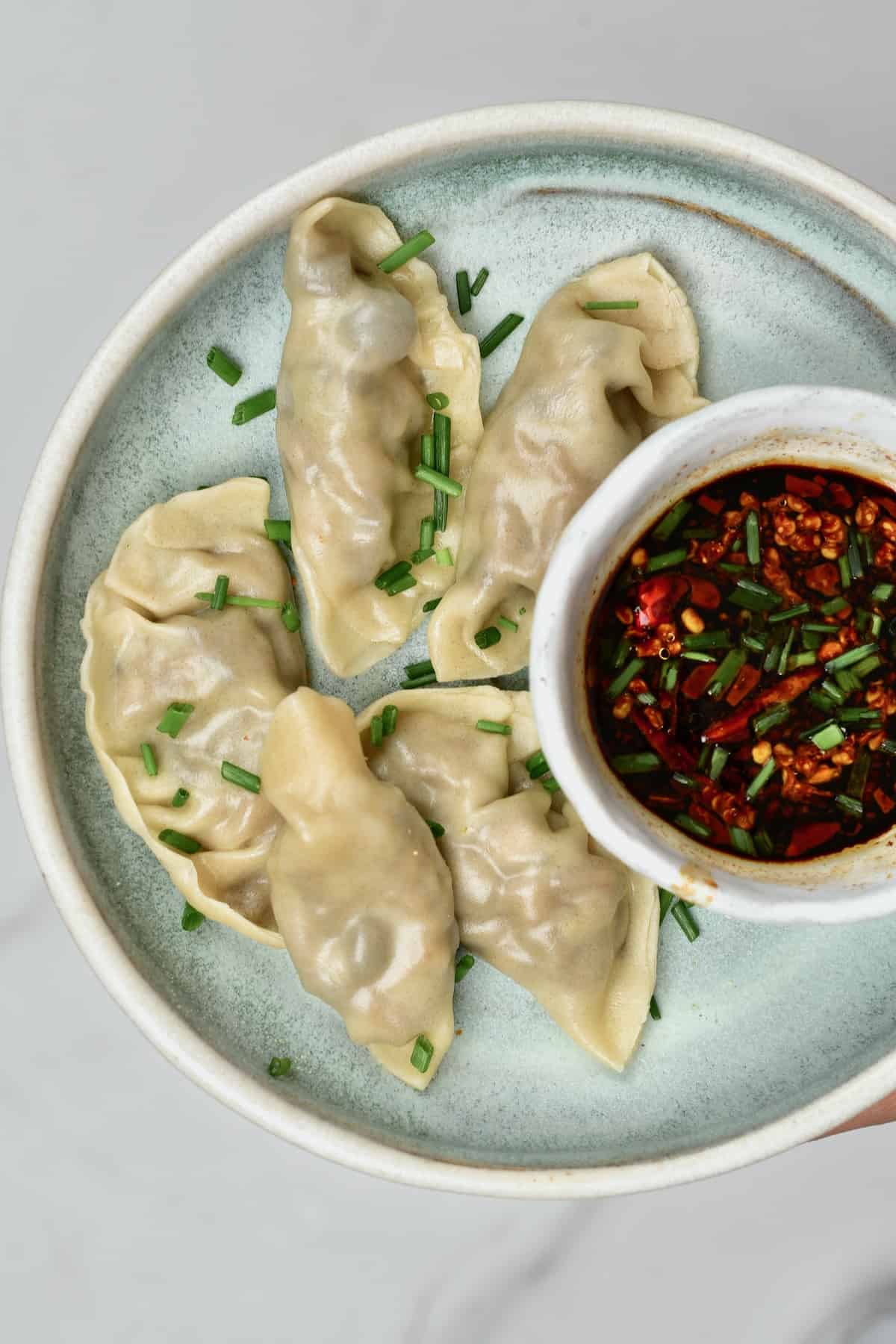
Having just shared this recipe for homemade dumpling wrappers, I, of course, had to follow up by making a large batch of one of my favorite kinds of vegan/vegetarian dumplings – mushroom dumplings.
These mushroom dumplings make for a great steamed dumpling, but you can also tweak the method to produce delicious crispy vegan potstickers (or gyoza) too! They’re also so much more cost-effective and fresh-tasting than takeout! It’s a win-win situation. Even those who have never made dumplings before will be surprised at how simple it is to make them!
I’m recently obsessed with mushrooms after sharing this method for perfectly sautéed mushrooms and wild mushroom ragu – now I’m officially ‘on a roll’ with these mushroom gyoza, too!
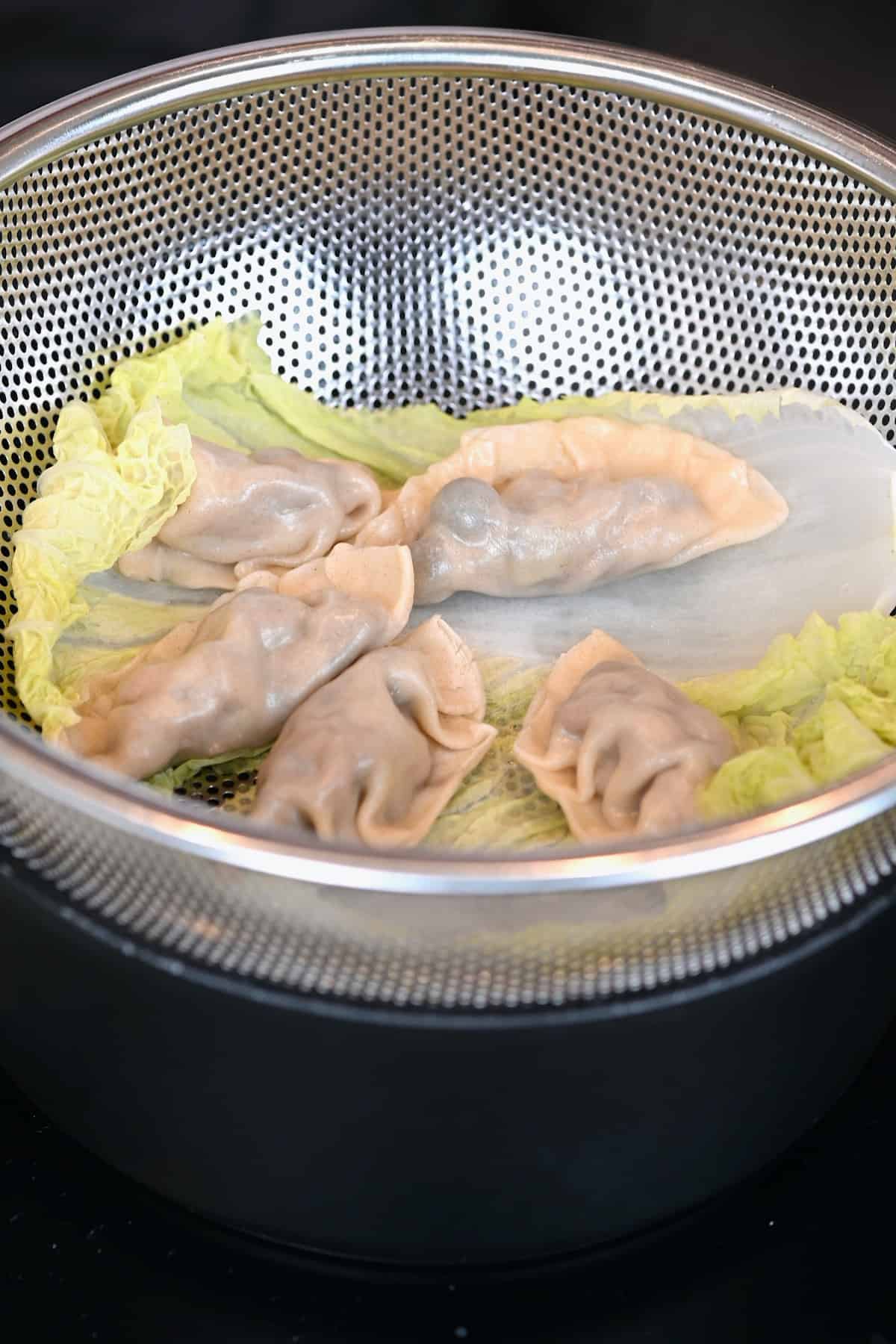
The only tricky part of this mushroom dumpling recipe is pleating the dumplings, and even I’m a beginner at that – but what my dumplings lack in style, they more than make up for in taste. Plus, this gives me the perfect excuse to make lots more homemade dumplings – practice makes perfect after all, right? And really with these dumplings, looks don’t matter – it’s what’s inside that counts!
While I tend to reserve these rainbow rice paper rolls for spring/summer, these vegan potstickers are perfect year-round, whenever the cravings hit! The mushroom filling is packed with flavor and yet simple enough that other ingredients don’t overshadow the mushrooms. When combined with a quick dumpling sauce, the delicious combination of salty, savory, spicy, and sweet is to die for!
Want to save this recipe?
What are Potstickers vs. Dumplings?
Technically potstickers are a type of pan-fried dumpling. The main difference is that, whereas dumplings are usually steamed or boiled to produce tender skins, potstickers are known for their crispy bottom due to a difference in the cooking method. Japanese gyoza is also prepared in a similar way to potstickers but is usually smaller with thinner dumpling skins.
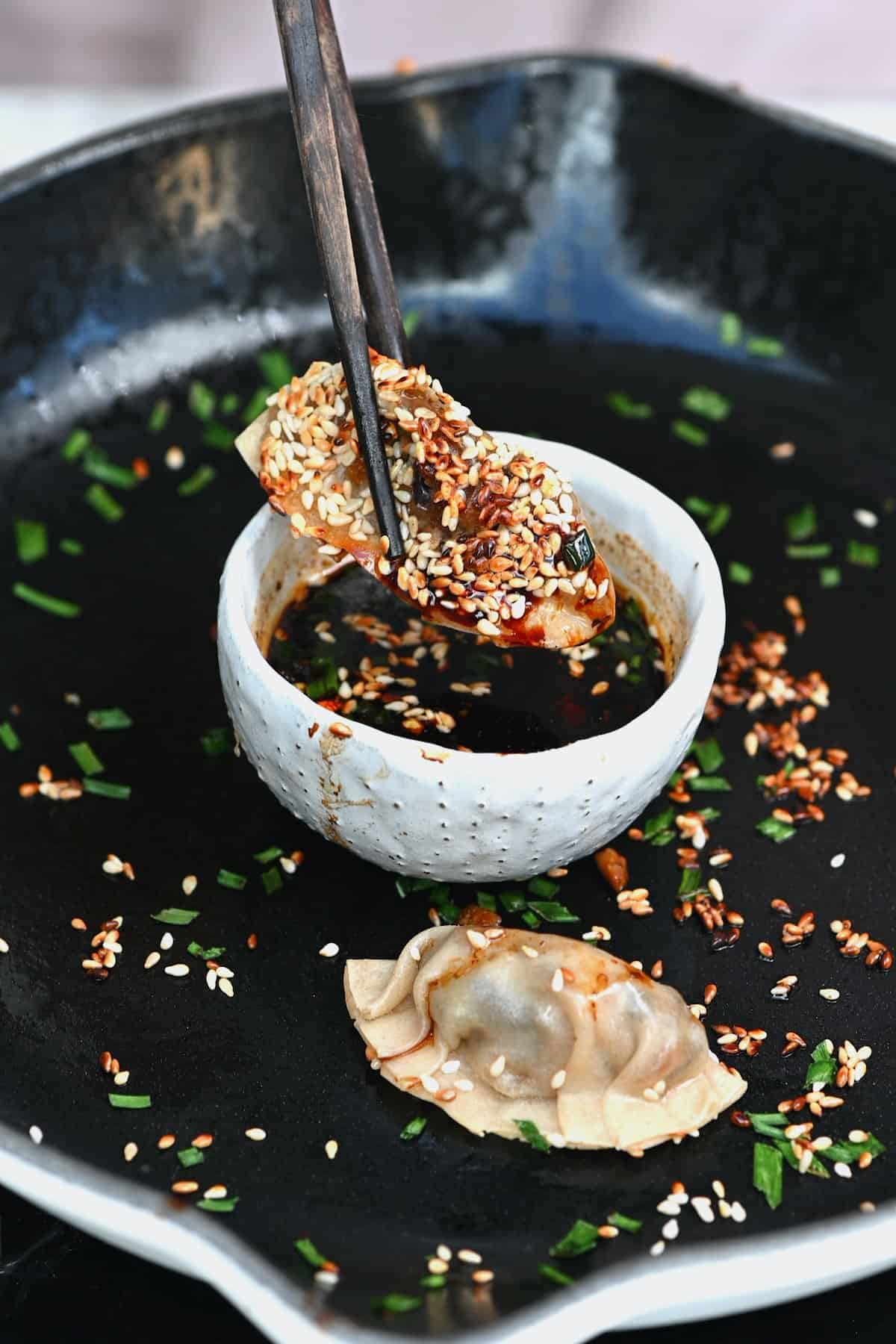
Potstickers were named after a chef forgot about his boiling dumplings, so the water boiled away, and the dumplings had stuck to the pot – hence “pot-stickers” (or guotie in Mandarin).
Within this post, I’ll take you through how to steam these mushroom dumplings to perfection for a tender bite or switch things up to make crispier mushroom potsticker, possibly even sesame-crusted, if that’s what floats your boat!
The Ingredients
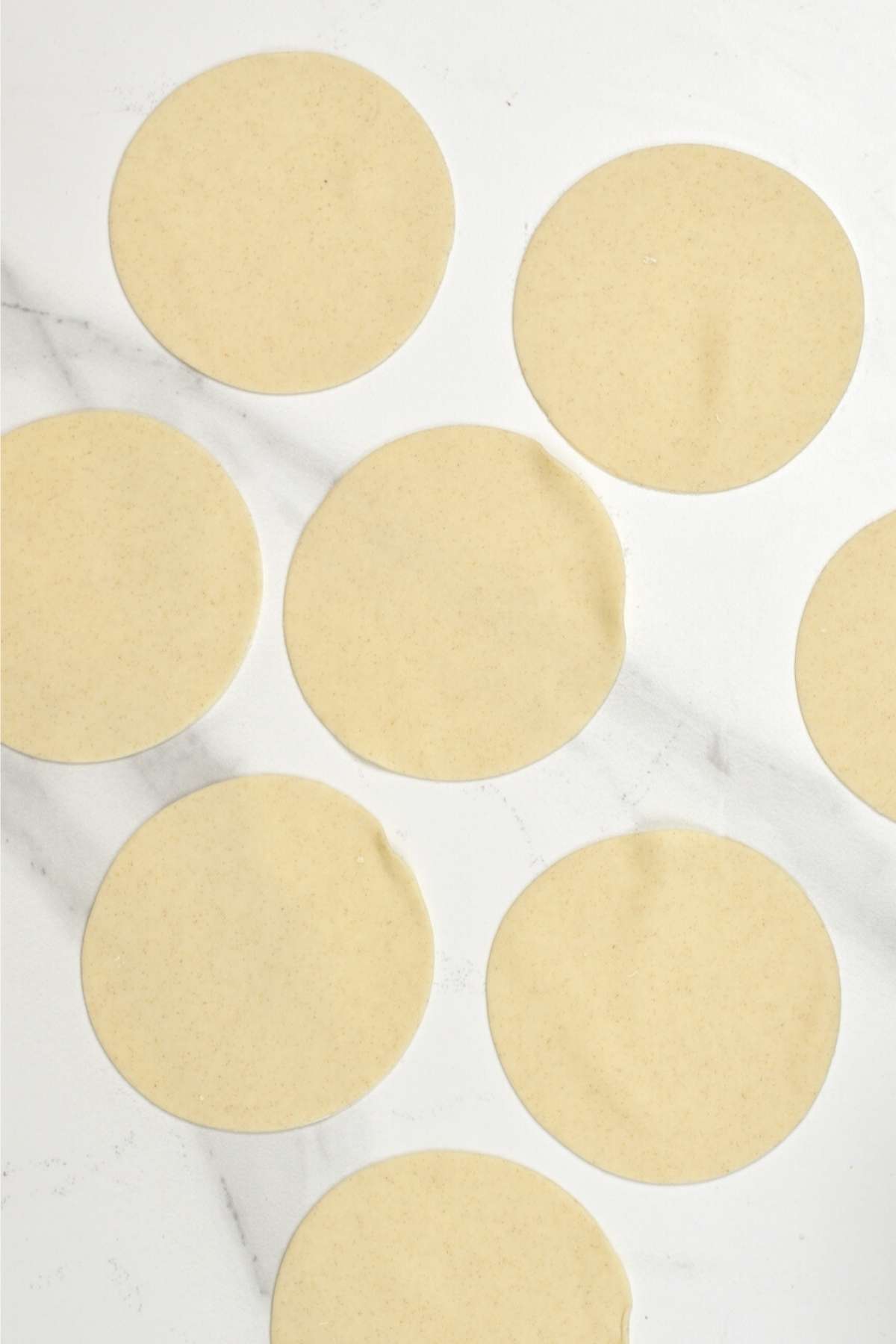
- Dumpling wrappers: I used these homemade dumpling wrappers. Feel free to use store-bought if preferred. They can be found fresh or frozen in most Asian supermarkets.
- Mushrooms: I used a combination of wild mushrooms that I can buy in combined packs. You could also use a single variety of mushrooms if preferred: oyster mushrooms, shiitake mushrooms (rehydrated), etc. will all work well.
- Cabbage: I used napa cabbage for a more traditional flavor – feel free to use other types, though.
- Aromatics: I use a simple combination of ginger and garlic with black pepper so the mushrooms aren’t overwhelmed. The soy sauce provides salt, so I don’t add any additional salt.
- Soy sauce: use tamari for a gluten-free option. You can also use reduced-sodium soy sauce if preferred. Though, I suggest using a combination of reduced and dark soy for depth of flavor.
- Sesame oil: used to sauté the mushroom filling and if making them as pan-fried vegan potstickers.
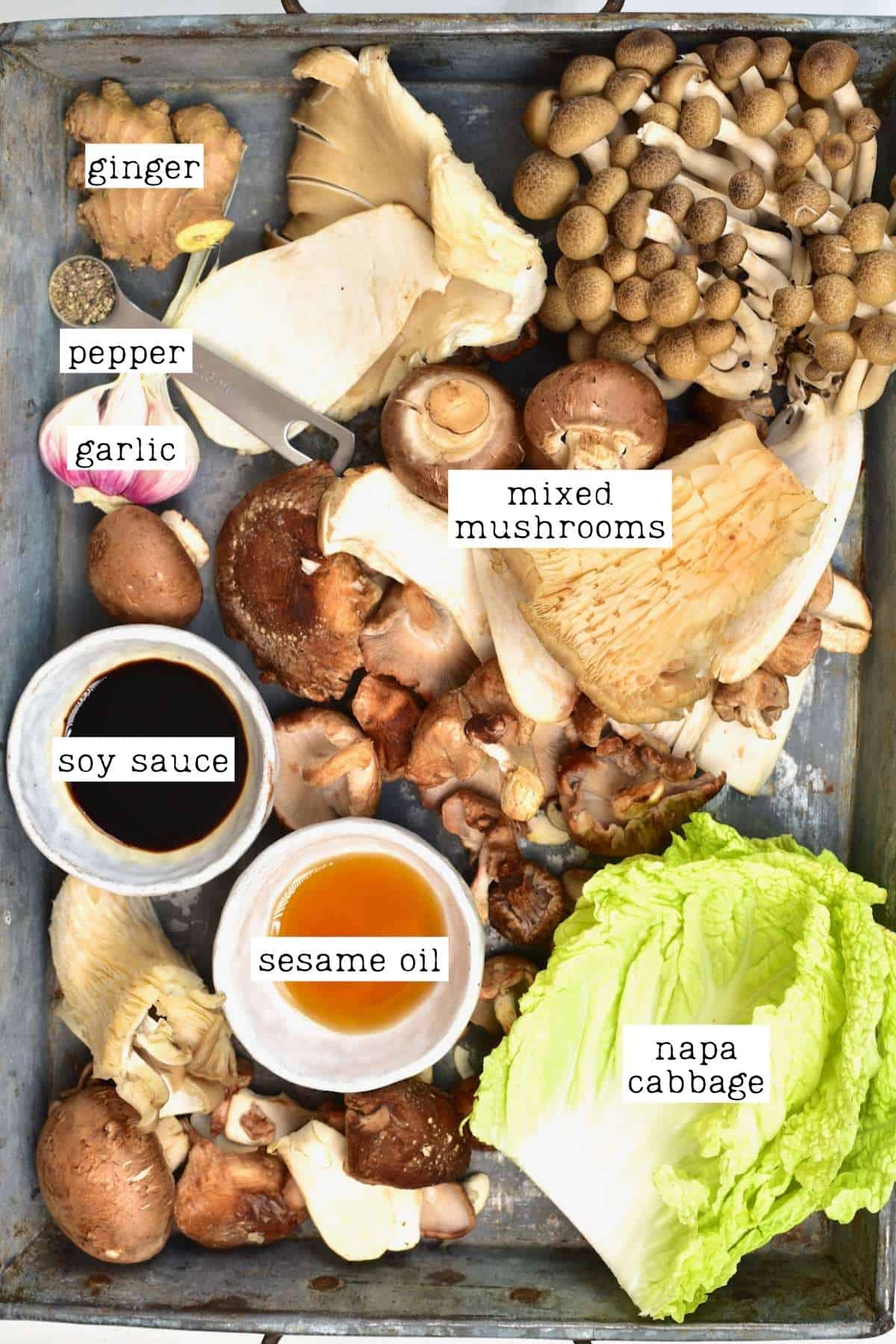
Recipe Variations
- Other vegetables: you can further bulk up the filling with shredded carrots, zucchini, red pepper, bamboo shoots, water chestnuts, etc. If doing so, I suggest reducing the mushrooms by 1/3 and replacing them with the other ingredient/s.
- Noodles: remove 1/3-1/2 of the mushrooms and replace them with cooked and cooled glass noodles.
- Protein: you could add finely chopped (or blitz it in a food processor) tofu for more protein. Meat eaters could use minced beef, pork, or shrimp.
- Spice: for more heat, add finely chopped chilies or red pepper flakes to the mushroom filling.
How To Make Mushroom Dumplings
If you haven’t made a batch of homemade dumpling wrappers already, then you can do so now or use store-bought wrappers.
Step 1: Prepare the mushroom filling
Start by finely chopping the cabbage, mushrooms, ginger, and garlic.
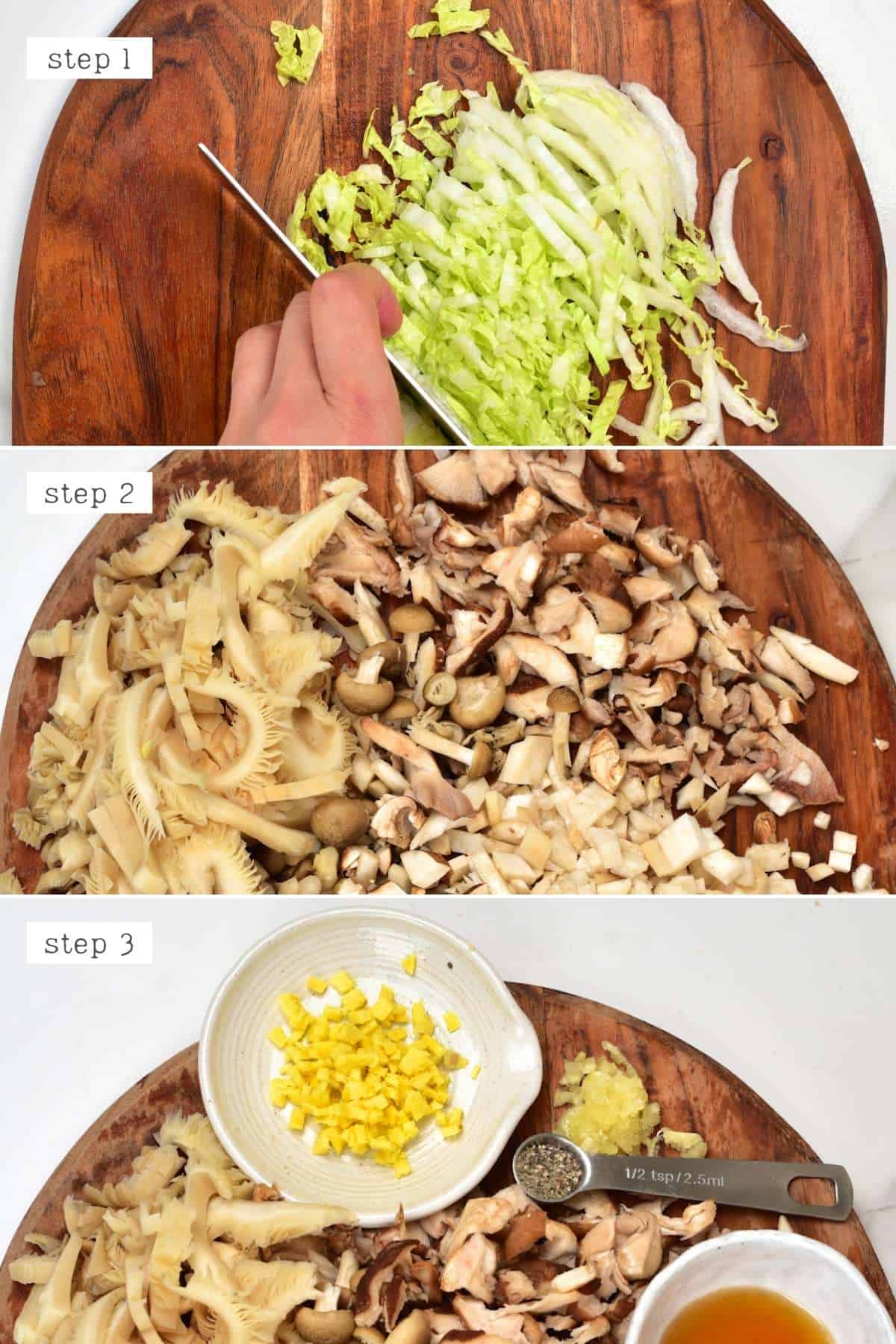
To save time, you can, alternatively, process the ingredients separately in a food processor until they are broken down into a chunky crumb. The mushrooms are okay in slightly larger pieces as they will cook down a lot, too.
Continue with cooking the mushrooms in a dry pan (no oil) over medium heat. As they cook, they’ll release their water content. After they’ve released the majority of their liquid, add in the remaining ingredients (including the oil) and cook for 4-5 minutes, or until tender, stirring occasionally.
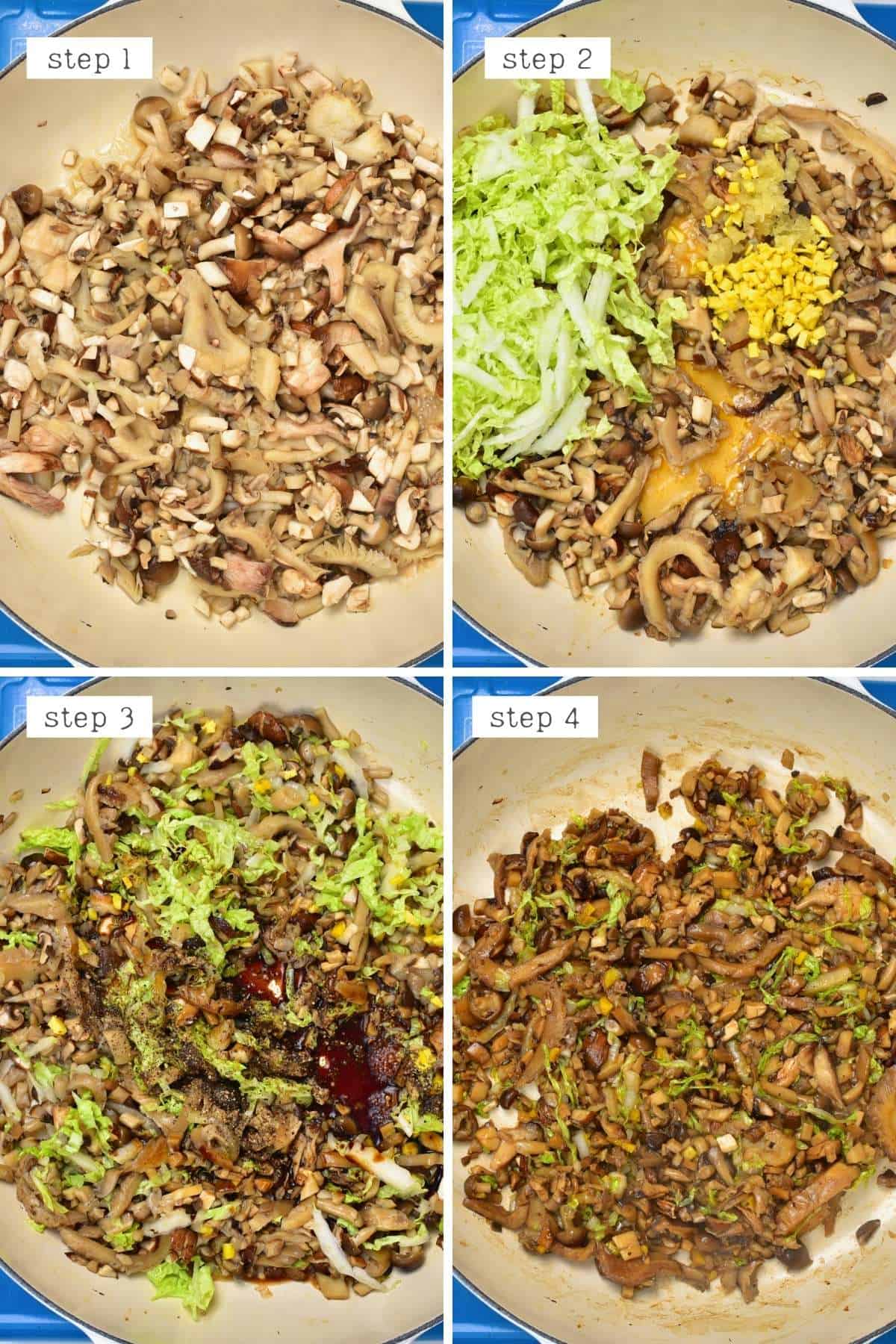
Taste the mushroom mixture and adjust the flavor if needed – more salt or soy. Then remove the mixture from the heat to allow it to cool for a few minutes.
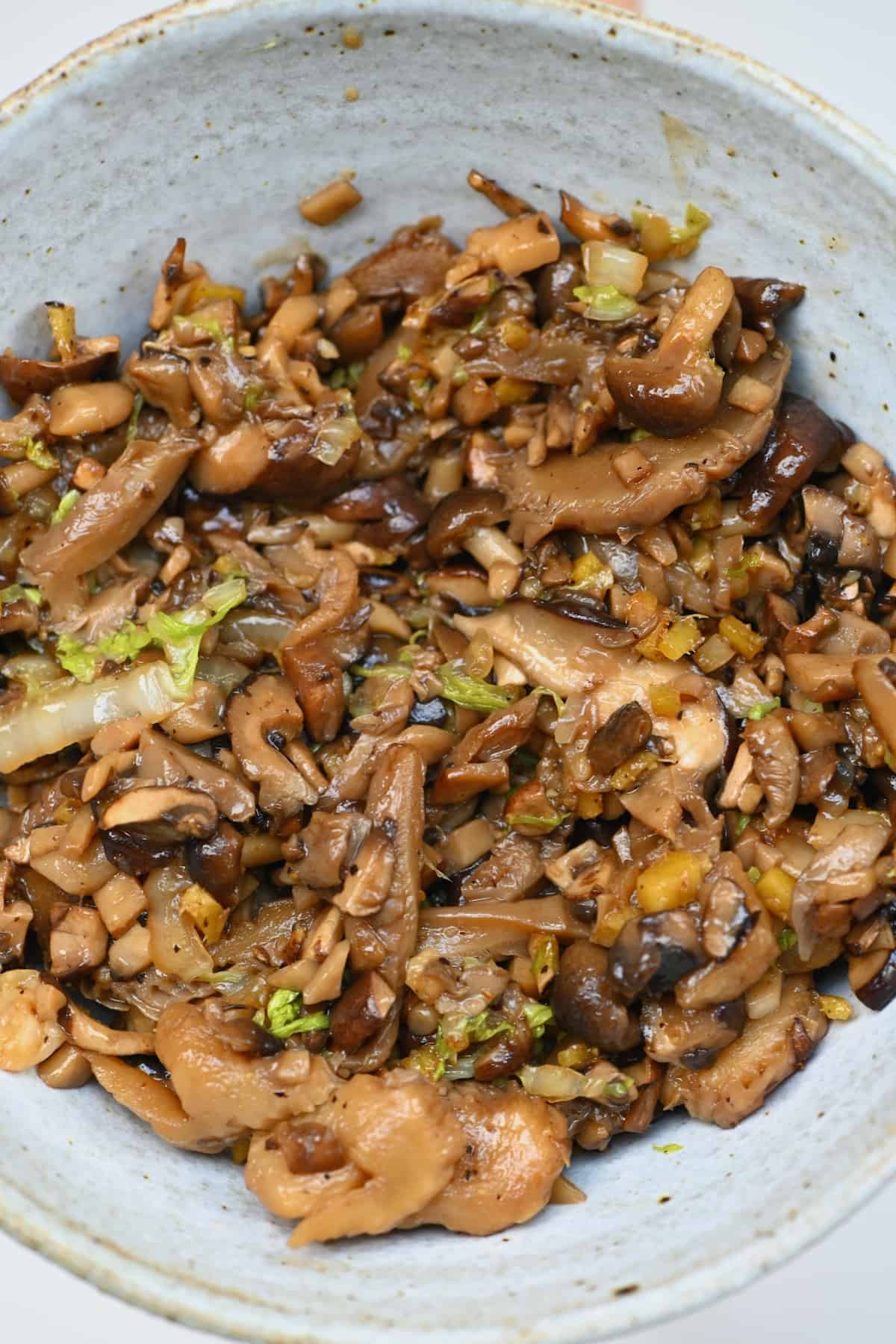
Step 2: Fill and shape the dumplings
To assemble the mushroom dumplings, fill each dumpling wrapper with around 1 Tbsp of the mushroom filling in the center. Then it’s time to shape the dumplings.
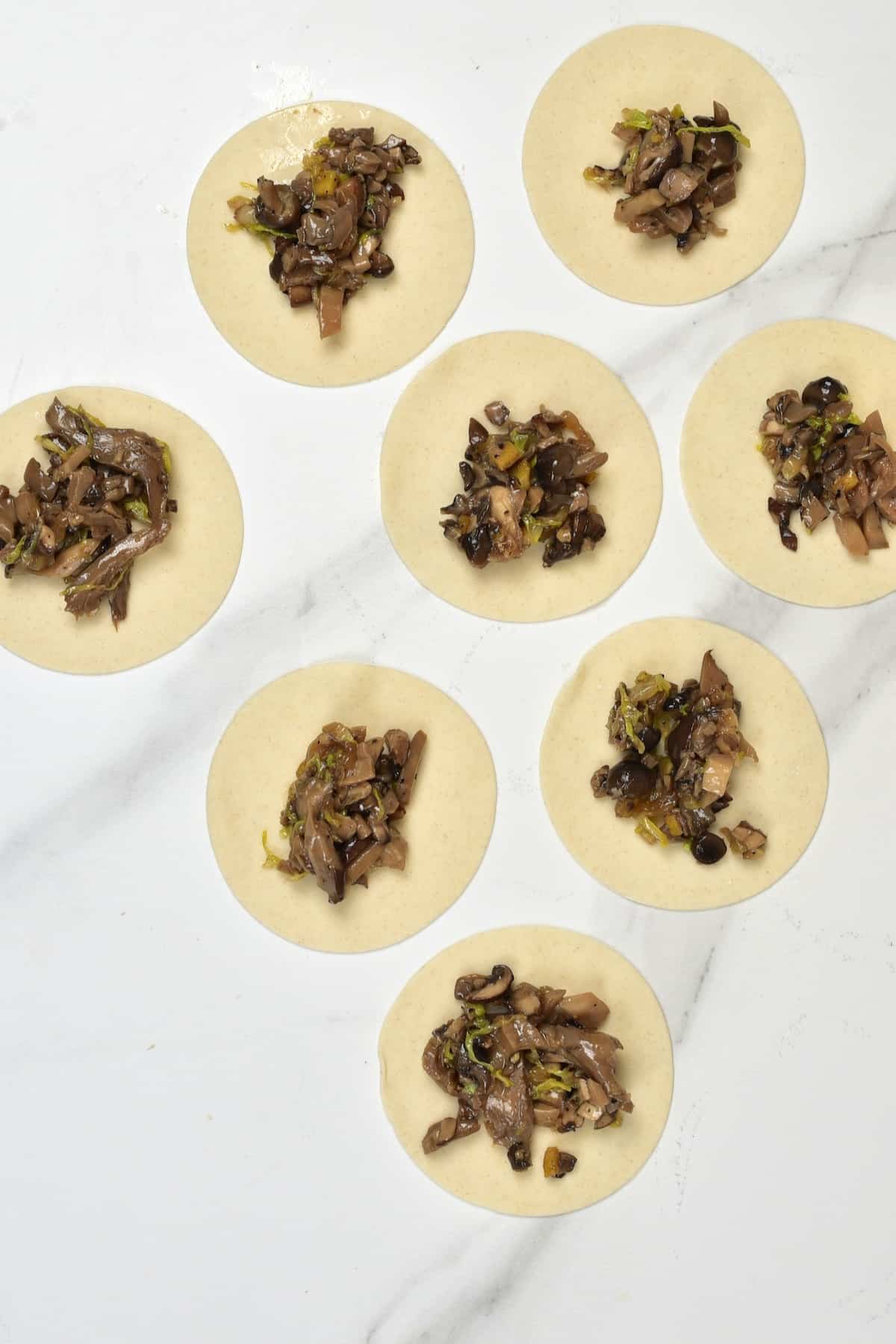
There are several ways that you can seal and shape the dumplings. I attempted a two-pleated design here.
To do this, press the center of the dumplings to seal and then create folds in the top layer of the dumpling to connect it to the bottom layer until fully sealed. You can direct them all one way or do 3 from the left and 3 from the right for a 2-directional pleat. There are several ways you can fold your dumplings, the easiest being the “half-moon” which requires you to just close and seal the dumpling without the need for extra pleats.
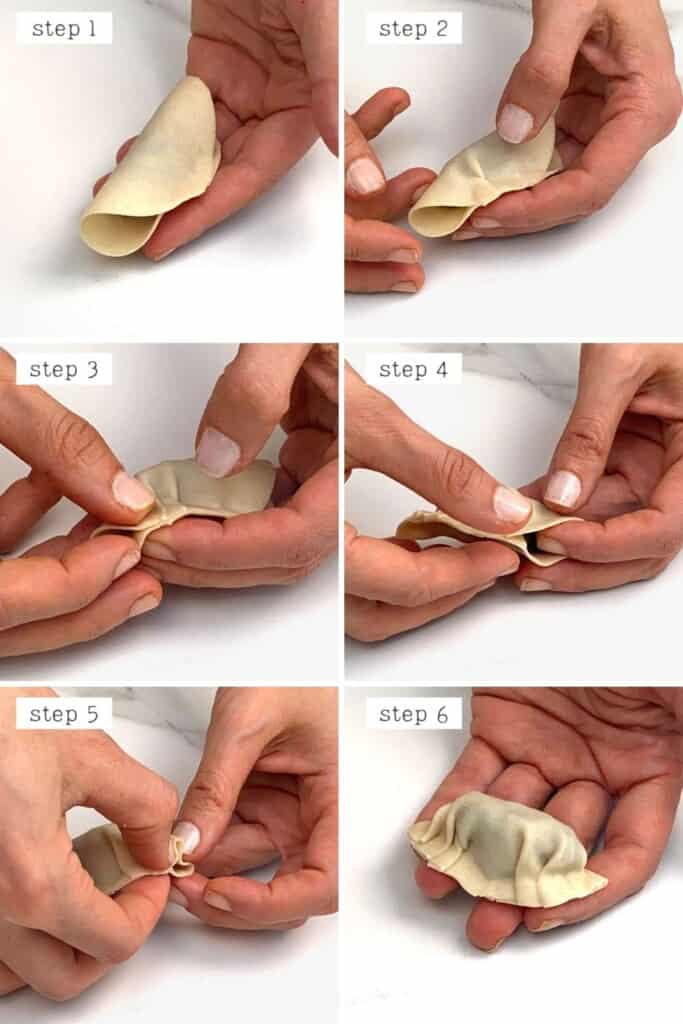
Another nice ‘beginner’ dumpling shape would be the ‘purse’/money bag dumplings. After spooning the filling directly into the center of the dumpling wrapper, then bring all the edges up and pinch it to seal. Optionally use chives/cilantro stems or something similar to tie around and hold the wrapper in place, like a little money bag.
Vegetarian/vegan dumpling filling is usually much ‘looser’ than ones with meat, so it can be a bit fiddly when pleating – have patience.
If you’re using store-bought or pre-frozen/starch-dusted wrappers, then use a little water to help you seal the dumplings properly.
Step 3: Cook the vegetarian dumplings
To Steam The Dumplings
There are several ways you can steam your dumplings, regardless of whether you have a bamboo steamer basket. I’ve included methods below for using a bamboo basket or colander. You can also use a tiered steaming pan.
First, line the bamboo basket (or tiered steaming pan) or colander with either ‘liners,’ a couple of cheesecloth layers, or some leftover napa (or regular) cabbage leaves. You could also use parchment paper – if doing so, I like to perforate it a few times to allow more steam to enter the basket.
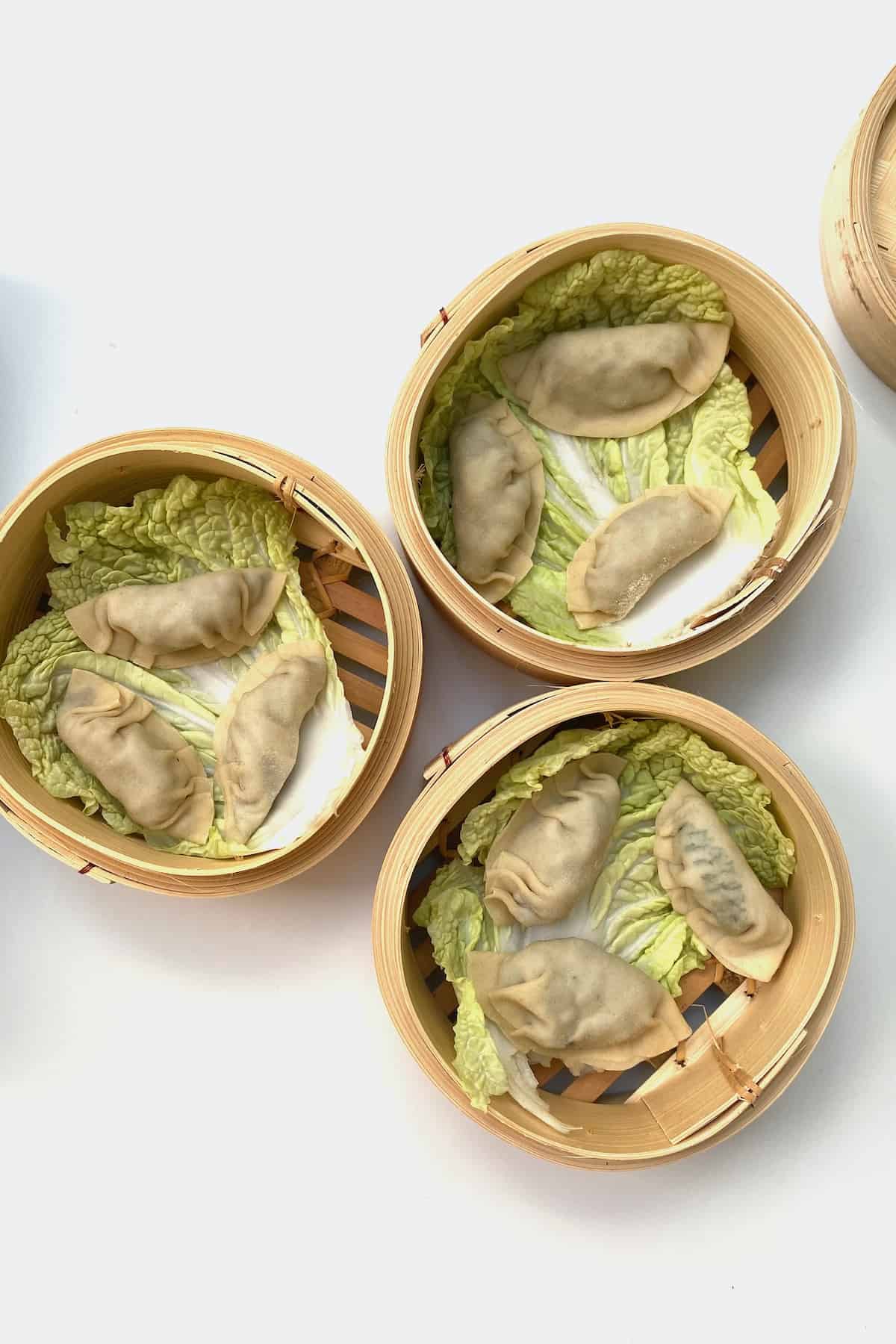
Chef’s tip: If you salt the napa cabbage leaves and leave them to one side for a few minutes, it will tenderize the leaves. You can then squeeze out the excess water, and they’ll fit much better within the steamer basket.
Place a few dumplings in the basket/colander, making sure that they don’t touch; otherwise, they’ll fuse. If you’re using a steamer basket/tiered steamer, fill both the basket’s levels and place the lid on top.
For the steamer basket
Add about 2-inches of water to a large skillet or pan and bring to a boil. Place the basket in the pan – the water should be touching the steamer but not be tall enough to reach the bottom of the basket.
I find it best to use a pan that’s not too much larger than the steamer so it’s snug around it to avoid too much of the steam escaping. Alternatively, you could use a smaller pot that the steamer sits snugly on top (so no steam escapes).
For the colander
Fill a pan that’s wide enough to accommodate your colander and fill it with a couple of inches of water – not enough to touch the bottom of the colander- and bring to a boil. Once boiling, place the colander within the pan and top with a lid.
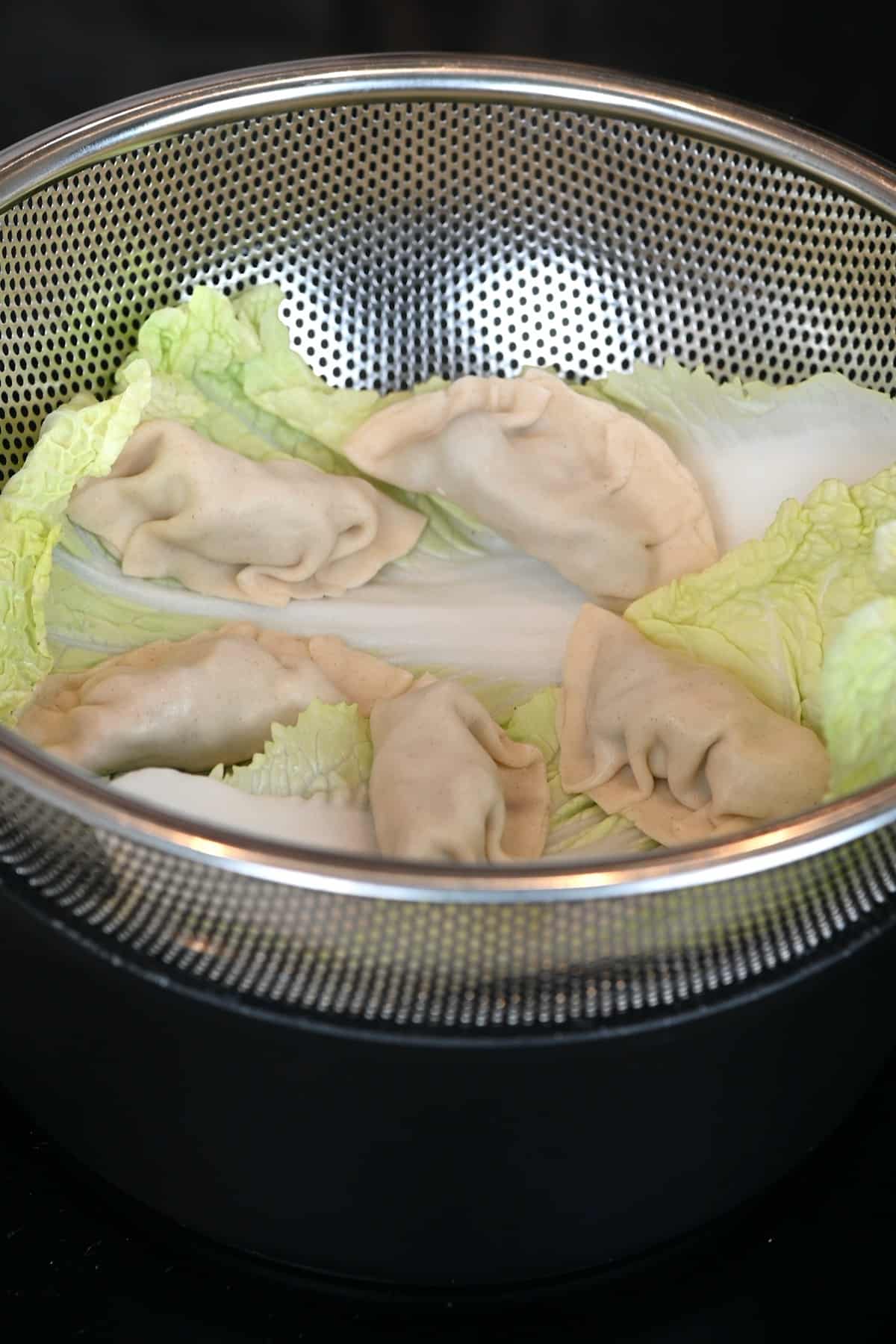
With both methods, reduce the heat to a simmer over medium-low heat and allow the dumplings to steam for 6-8 minutes. Make sure not to remove the lids at any point or you’ll let all of the steam escape. The dough should be slightly opaque and cooked through when done.
When ready, remove the dumplings from the basket/colander quickly to avoid them over-steaming.
For Pan-fried Vegan Potstickers
After filling and shaping the mushroom dumplings, it’s time for frying and steaming potstickers (this is also the same method you’d use for mushroom gyoza)
(Optional) For a sesame-crusted potsticker: Brush the bottom of each vegan potsticker with some water and coat them with raw sesame seeds.
Using a large skillet, add a tablespoon of sesame oil to the pan and allow it to heat up. Then add enough dumplings to fill the skillet without touching. Fry over medium heat for around 2 minutes until the bottom of the potstickers has browned and become slightly crispy.
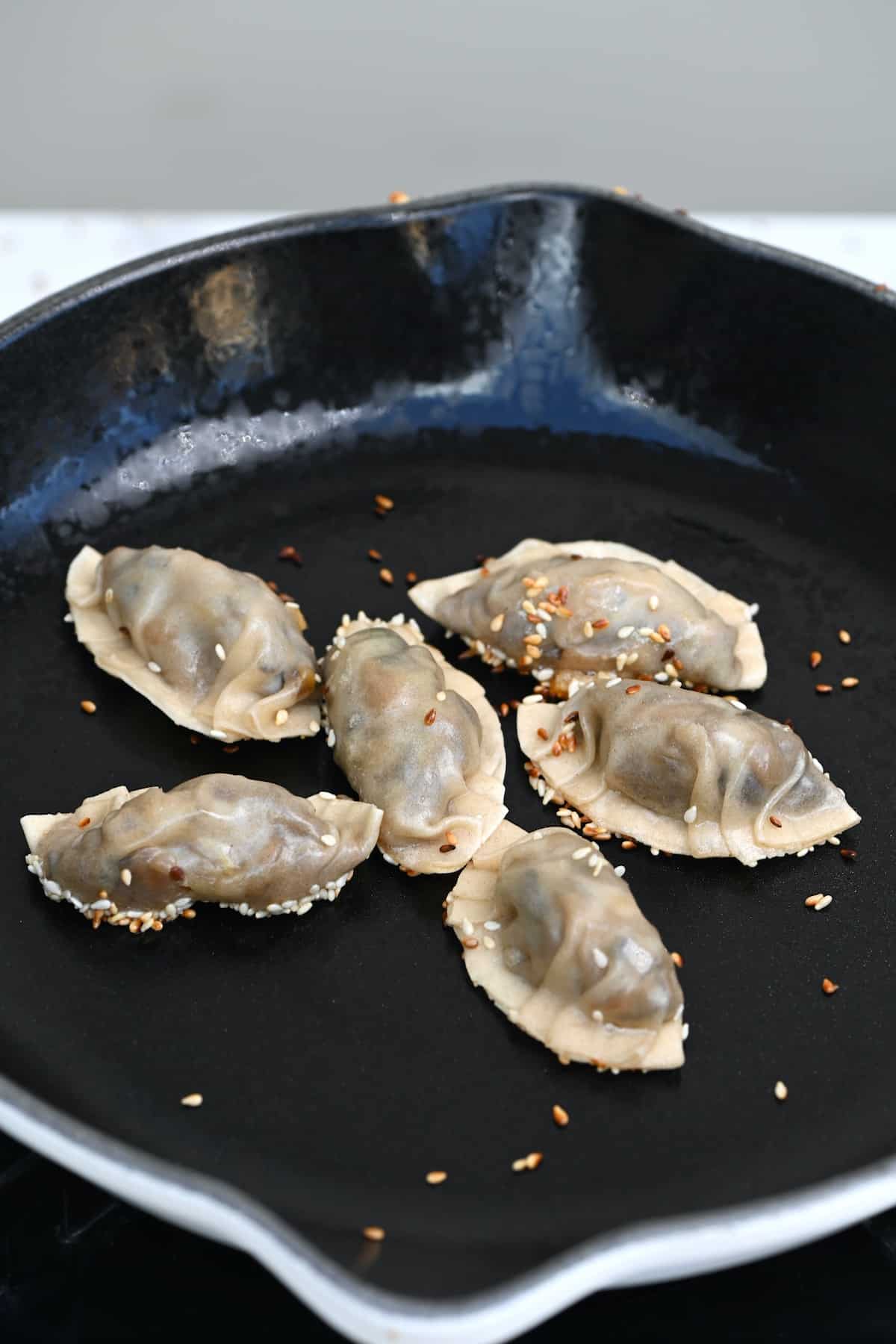
Then carefully (it will likely splatter), add 1/2 cup (120ml) of water to the pan and cover with a tight-fitting lid, reducing the temperature to medium-low.
Allow the mushroom dumplings to steam for 7-9 minutes until the liquid is almost all evaporated, then remove the lid. Increase the heat slightly and cook for just 1-2 minutes further for the remainder of the liquid to cook off and the bottom of the vegan potstickers to crisp up once more.
Serve immediately with this gyoza dipping sauce or your sauce of choice. You can also use them to make dumpling soup.
How To Make Ahead and Store
Make ahead: these mushroom dumplings are super freezer-friendly. You can prepare these up until the point just before cooking and then freeze them in a single layer on a baking sheet until solid before transferring to an airtight freezer-safe bag or container for up to 1 month.
Store: freshly cooked vegan potstickers are best eaten immediately. However, leftovers will store in an airtight container in the fridge for 2-3 days.
Reheat: you can steam these dumplings from frozen – add an extra 3-4 minutes to the steaming time – this includes using the potsticker cooking method. To reheat dumplings from the fridge, you can re-steam, oven bake or microwave them until warmed through.
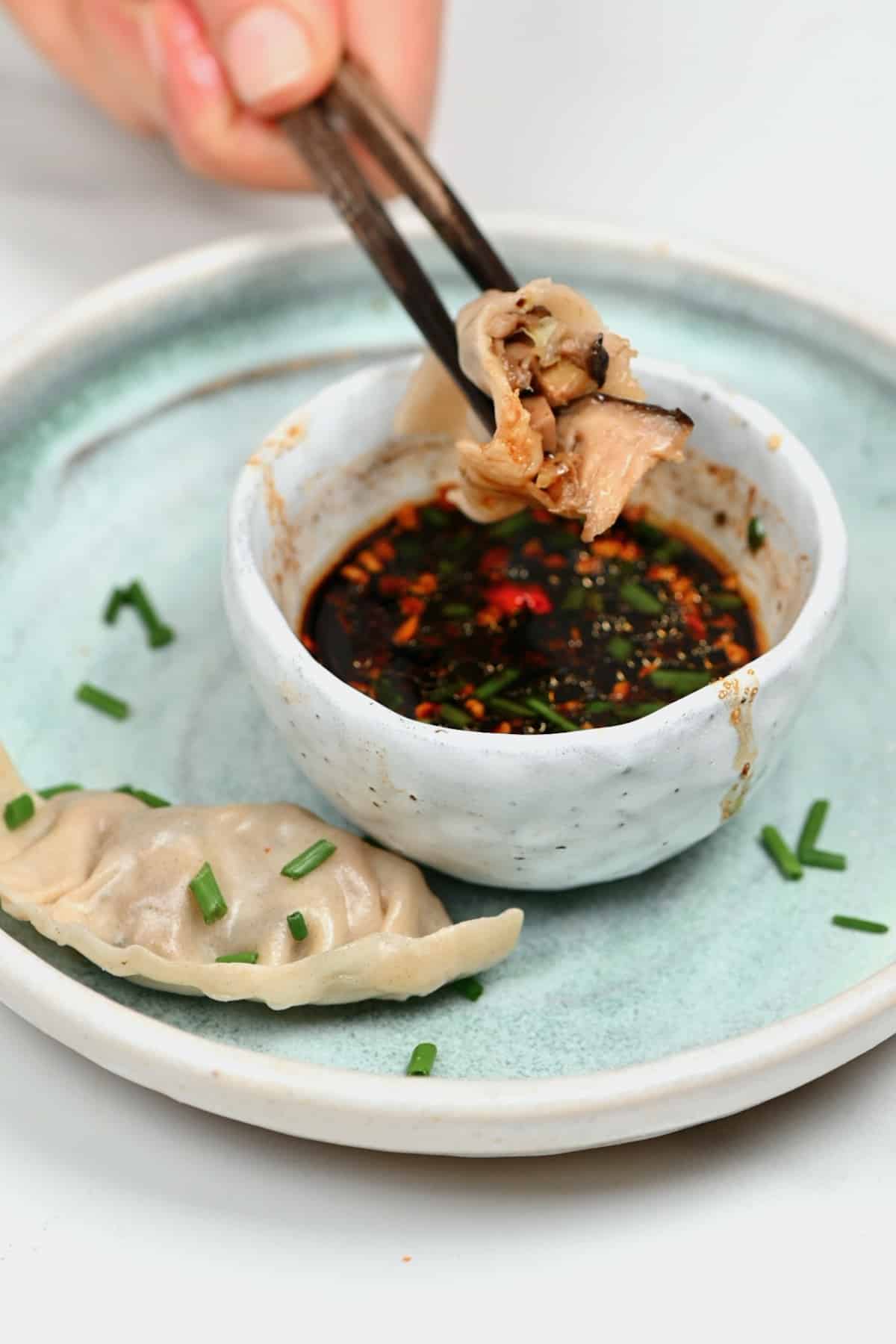
Recipe Notes
- When making potstickers: when you add the water to the pan, it can splatter, so be careful. Standing back is recommended.
- For quick prep: you can use a food processor to chop ingredients quickly. However, it can impact mushroom texture somewhat to feel free to experiment and see which you prefer.
- If you’re new to steaming dumplings, you can check their doneness by inserting a toothpick into the center of a dumpling. Leave it there for a few seconds, then remove it and press it against your bottom lip. It should be very hot.
- As well as steaming and frying dumplings, you can also boil them. However, incorrectly pleated dumplings may fall apart when boiled – potstickers/gyoza are far more forgiving on newbie dumpling makers!
- If you have a tiered steaming pan: these pans usually come in three layers: a tall pot at the bottom and two steaming layers above. To use this, line the layers, add a few inches of water to the bottom pan and bring to a boil. Add the dumplings (not touching) to both upper steamer pans, then pop on the lid and allow them to steam.
Other Asian-Inspired Recipes
- Vegetable Lo Mein (Chili Garlic Noodles)
- Pad Kra Pao
- Fresh Rainbow Rice Paper Rolls
- How to make chili oil
- Asian cucumber Salad (Sunomono)
- Jackfruit Donburi Bowl
- Ramen Noodle Soup
- Rainbow Vegetarian Bibimbap
- Korean Vegetable Pancake (Buchimgae/Pajeon)
- Crispy Rice Paper Dumplings
If you try this steamed mushroom dumplings recipe, I’d love to hear your thoughts/questions below. Also, I’d appreciate a recipe card rating below, and tag me in your recipe recreations on Instagram @Alphafoodie!

Steamed Mushroom Dumplings (Vegan Potstickers)
Ingredients
- 16 dumpling wrappers
- 5 cups mushrooms mixed or not
- 1 Tbsp soy sauce reduce-sodium, regular, or tamati for gluten-free are all welcome.
- 1 Tbsp sesame oil
- 3 napa cabbage leaves or other cabbage
- 2-3 garlic cloves
- 2 inch ginger knob
- 1/2 tsp black pepper
Instructions
- If you haven't made a batch of homemade dumpling wrappers already, then you can do so now or use store-bought wrappers.
Step 1: Prepare the mushroom filling
- Finely chop the cabbage, mushrooms, ginger, and garlic.To save time, you can, alternatively, process the ingredients separately in a food processor until it's broken down into a chunky crumb. The mushrooms are okay in slightly larger pieces as they will cook down a lot, too.
- Cook the mushrooms in a dry pan (no oil) over medium heat. As they cook, they'll release their water content. After they've released the majority of their liquid, add in the remaining ingredients (including the oil) and cook for 4-5 minutes, or until tender, stirring occasionally.Taste the mushroom mixture and adjust the flavor if needed; more salt or soy. Then remove the mixture from the heat to allow it to cool for a few minutes.
Step 2: Fill and shape the dumplings
- To assemble the mushroom dumplings, fill each dumpling wrapper with around 1 Tbsp of the mushroom filling in the center. Then it's time to shape the dumplings.There are several ways that you can seal and shape the dumplings. I attempted a two-pleated design.
- To do this, press the center of the dumplings to seal and then create folds in the top layer of the dumpling to connect it to the bottom layer until fully sealed. You can direct them all one way or do 3 from the left and 3 from the right for a 2-directional pleat. There are several ways you can fold your dumplings, though, the easiest being the “half-moon” which requires you to just close and seal the dumpling without the need for extra pleats. Another nice 'beginner' dumpling shape would be the 'purse'/money bag dumplings. After spooning the filling directly into the center of the dumpling wrapper, then bring all the edges up and pinch it to seal. Optionally use chives/cilantro stems or something similar to tie around and hold the wrapper in place, like a little money bag.
- If you're using store-bought or pre-frozen/starch-dusted wrappers, then use a little water to help you seal the dumplings properly.
Step 3: Cook the vegetarian dumplings
To Steam The Dumplings
- There are several ways you can steam your dumplings, regardless of whether you have a bamboo steamer basket. In fact, I've included methods below for using a bamboo basket or colander. You can also use a tiered steaming pan.First, line the bamboo basket or colander with either 'liners,' a couple of cheesecloth layers, or some leftover napa (or regular) cabbage leaves. You could also use parchment paper – if doing so, I like to perforate it a few times to allow more steam to enter the basket.Chef's tip: If you salt the napa cabbage leaves and leave them to one side for a few minutes, it will tenderize the leaves. You can then squeeze out the excess water, and they'll fit much better within the steamer basket.
- Place a few dumplings in the basket/colander, making sure that they don't touch; otherwise, they'll fuse. If you're using a steamer basket, fill both the basket's levels and place the lid on top.For the steamer basket: Add about 2-inches of water to a large skillet or pan and bring to a boil. Place the basket in the water- the water should be touching the steamer but not enough to reach the food.I find it best to use a pan that's not too much larger than the steamer. so it's snug around it to avoid too much of the steam escaping. Alternatively, you could use a smaller pot that the steamer sits snugly on top (so no steam escapes).For the colander: Fill a pan that's wide enough to accommodate your colander and fill it with a couple of inches of water – not enough to touch the bottom of the colander- and bring to a boil. Once boiling, place the colander within the pan and top with a lid.With both methods, reduce the heat to a simmer over medium-low heat and allow the dumplings to steam for 6-8 minutes. Make sure not to remove the lids at any point or you'll let all of the steam escape. The dough should be slightly opaque and cooked through when done.
- When ready, remove the dumplings from the basket/colander quickly to avoid them over-steaming.
For Pan-fried Vegan Potstickers
- After filling and shaping the mushroom dumplings, it's time for frying and steaming potstickers.(Optional) For a sesame-crusted potsticker: Brush the bottom of each vegan potsticker with some water and coat them with raw sesame seeds.
- Using a large skillet, add a tablespoon of sesame oil to the pan and allow it to heat up. Then add enough dumplings to fill the skillet without touching. Fry over medium heat for around 2 minutes until the bottom of the potstickers has browned and become slightly crispy.
- Then carefully (it will likely splatter), add 1/2 cup (120ml) of water to the pan and cover with a tight-fitting lid, reducing the temperature to medium-low.
- Allow the mushroom dumplings to steam for 7-9 minutes until the liquid is almost all evaporated, then remove the lid. Increase the heat slightly and cook for just 1-2 minutes further for the remainder of the liquid to cook off and the bottom of the vegan potstickers to crisp up once more.
- Serve immediately with this gyoza dipping sauce or your sauce of choice.
How To Make Ahead and Store
- Make ahead: these mushroom dumplings are super freezer-friendly. You can prepare these up until the point just before cooking and then freeze them in a single layer on a baking sheet until solid before transferring to an airtight freezer-safe bag or container for up to 1 month.Store: freshly cooked vegan potstickers are best eaten immediately. However, leftovers will store in an airtight container in the fridge for 2-3 days.Reheat: You can steam these dumplings from frozen – add an extra 3-4 minutes to the steaming time – this includes using the potsticker cooking method. To reheat dumplings from the fridge, you can re-steam, oven bake, or microwave them until warmed through.
Notes
- When making potstickers: When you add the water to the pan, it can splatter, so be careful – standing back is recommended.
- For quick prep: You can use a food processor to chop ingredients quickly. However, it can impact mushroom texture somewhat to feel free to experiment and see which you prefer.
- If you’re new to steaming dumplings, you can check their doneness by inserting a toothpick into the center of a dumpling. Leave it there for a few seconds, then remove it and press it against your bottom lip – it should be very hot.
- As well as steaming and frying dumplings, you can also boil them. However, incorrectly pleated dumplings may fall apart when boiled – potstickers/gyoza are far more forgiving on newbie dumpling makers!
- If you have a tiered steaming pan: These pans usually come in three layers, a tall pot at the bottom and two steaming layers above. To use this method, line the layers, add a few inches of water to the bottom pan and bring it to a boil, add the dumplings (not touching) to both upper steamer pans, then pop on the lid and allow them to steam.
Nutrition
Nutrition information is automatically calculated, so should only be used as an approximation.
























